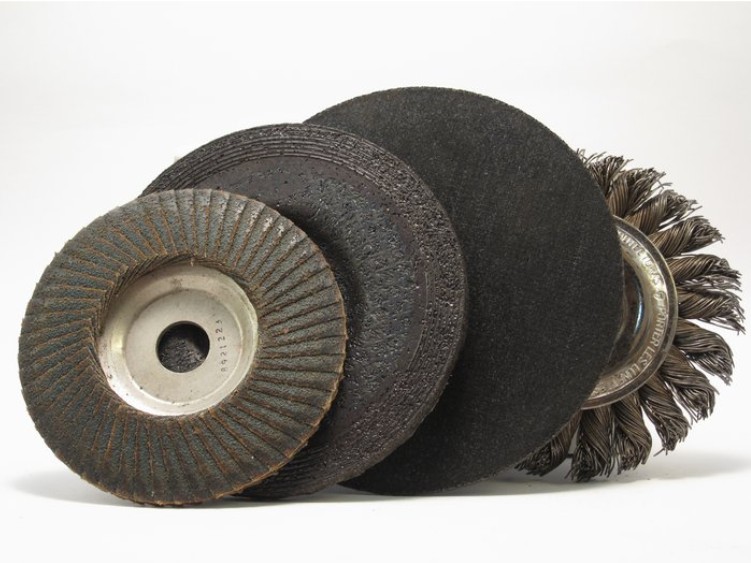In industrial applications, *grinding discs* are paramount in achieving precision cuts, smooth finishes, and a wide variety of material removal. From metal fabrication and automotive repairs to construction projects, the right grinding disc material will affect productivity and the end goals significantly. This knowledge is necessary to optimize industrial processes and to make well-informed decisions.
Note: The largest stock of NKK grinding and cutting discs for all types of work is now available in our warehouse. If you are looking for high-quality grinding or cutting discs, feel free to explore and shop on our website: https://www.udo.co.th/category_product/ใบตัดใบเจียร.
The Composition of Grinding Discs Explained
The manufacture of grinding discs includes abrasive grains, bonding agents, and reinforcements. The kind of abrasive grain and filling material determines the disc performance, durability and suitability for application. The key components of a grinding disc are as follows:
1. Abrasive Grains
The grains abrasives are bonded into the backbone for grinding disc. Generally used materials are:
- Aluminum Oxide: Aluminum oxide is a versatile media best used for grinding ferrous metals such as steel and iron. Its toughness makes it suitable for general-purpose grinding.
- Silicon carbide: A harder, more brittle abrasive than aluminum oxide. It works great for non-ferrous metals, ceramics, and stone.
- Zirconia Alumina: Perfect for heavy-duty applications, zirconia alumina offers the best wear resistance and cutting performance.
- Diamond Abrasive: Diamonds are the most sought-after material for high-resolution work, such as being used to cut and grind hard materials such as glass, cement and ceramics.
2. Bonding Agents
The bonding agents keep the abrasive grains together and determine how the disc performs. Common types include:
- Resin Bond: Flexibility and high-speed utility
- Vitrified Bond: Provides rigidity as well as strength for precision grinding.
- Metal Bond: Last longer; Used for diamond and superabrasive discs
3. Reinforcement
Safety in Power Tools: You may be glad to know that the safety of power tools is one of the reasons why grinding discs have been strengthened with several layers of fiberglass or similar materials, specifically intended to withstand high speed – a safety net.
Choosing the Right Material for Your Grind Disc
Which grinding disc material to use will depend on both the specific job that you are performing and the workpiece material being worked on. Here are some key considerations:
1. Material Compatibility
That means you need to comprehend what the material you’re going to be grinding is. For instance:
- Aluminum oxide discs are suited for steel and ferrous metals.
- Use silicon carbide for glass, ceramics, or plastics.
- For heavy grinding applications on hard alloys, select zirconia alumina.
2. Speed and Efficiency in Grinding
For faster material removal on rough surfaces, opt for wider and more durable bonding agents. For a smooth finish, finer grit and specific materials like diamond abrasives are best.
3. Durability and Longevity
Industrial solutions require tools that can take a beating. Zirconia alumina or diamond abrasives creates a longer-lasting disc, which means less downtime and less money spent on replacements.
4. Safety and Reinforcement
Ensure you choose a disc that has proper layers of reinforcement and minor investment in high-speed grinder/power tools to minimize the risk of your disc breaking off.
Grinding Disc Materials in Industry
1. Metal Fabrication
Metal fabrication tasks, from deburring to shaping and finishing metal parts, cannot do without grinding discs. Some examples are aluminum oxide and zirconia alumina.
2. Construction
Cutting and smoothing concrete, stone, masonry surfaces are done using grinding discs in construction. The use of silicon carbide and diamond abrasives is very common in this sector due to their extreme hardness and efficiency.
3. Automotive Repairs
A grinding disc is essential to automotive repair shops, as it’s used for everything from removing paint to shaping metal parts. Both aluminum oxide and zirconia alumina are effective for this kind of work.
How to Get the Most Out of Your Grinding Disc
To enhance both the performance and service life of your grinding disc:
- Get the Right Disc: Pick the right material and grit for the job.
- Use a Proper Speed Settings: Follow the manufacturer’s recommended speed limits.
- Keep Your Tools in Shape: Repair or replace worn-down discs to improve safety and efficiency.
- Storage: Store your grinding discs in a cool, dry environment or it will damage by moisture or heat.
Conclusion
Comprehending various grinding disc materials and their applications is another area where investing time can pay dividends in industrial productivity. When using metals, stone, or other materials, choosing the correct disc yields improved results, productivity and safety. This level of consideration can help industries maximize their grinding operations by evaluating things like material compatibility, durability, and application specifications.
Designed and manufactured with decades of industry experience, look at new products and offerings in the market to find out the best grinding disc materials for your specific needs. Using the right grinding disc for the right tool is a small decision that can make a big difference in your productivity and the life of your tools, making them a must-have for any industry.
